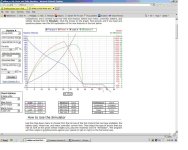The Mighty Volt
1 MW
Hi.
I've been doing some basic tricking around on the very entertaining Ebikes.ca simulator II
http://ebikes.ca/simulator/
The general theory is to volt up, keep the amps down.
According to the sim, An X5303 needs to reach 28 Mph to enter a state where it will "Never" overheat, when a system of 59v and a 40A controller are used with a 20" wheel and 220lb rider,on an 8.5% grade. Consumption is 71.6Wh/Mile at that speed, 28.5Mph. Range is 7.1miles at that speed from a 10Ah pack.
However, according to the same sim, once a switch is made to 72v, the same rider must bring the bike up to around 36 MPH in order to avoid overheating. Energy consumption at that point is 69.7 Wh/Mile. Under the same system, Consumption is 88 Wh per mile at 28 MPH.
Am I missing something here???
I've been doing some basic tricking around on the very entertaining Ebikes.ca simulator II
http://ebikes.ca/simulator/
The general theory is to volt up, keep the amps down.
According to the sim, An X5303 needs to reach 28 Mph to enter a state where it will "Never" overheat, when a system of 59v and a 40A controller are used with a 20" wheel and 220lb rider,on an 8.5% grade. Consumption is 71.6Wh/Mile at that speed, 28.5Mph. Range is 7.1miles at that speed from a 10Ah pack.
However, according to the same sim, once a switch is made to 72v, the same rider must bring the bike up to around 36 MPH in order to avoid overheating. Energy consumption at that point is 69.7 Wh/Mile. Under the same system, Consumption is 88 Wh per mile at 28 MPH.
Am I missing something here???


